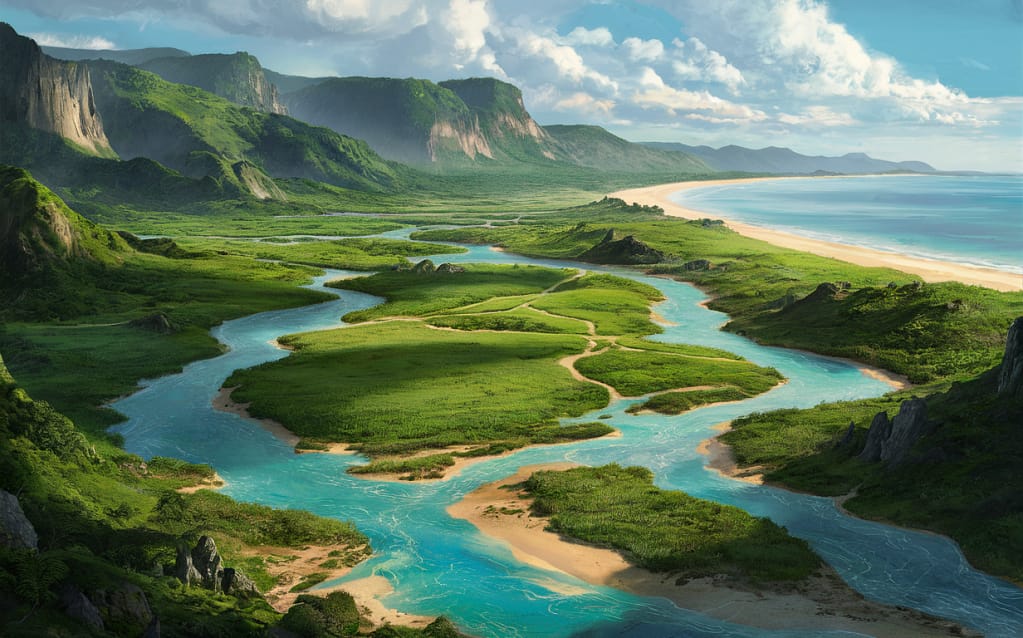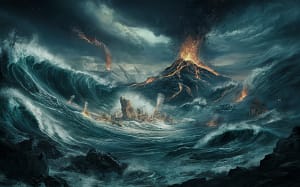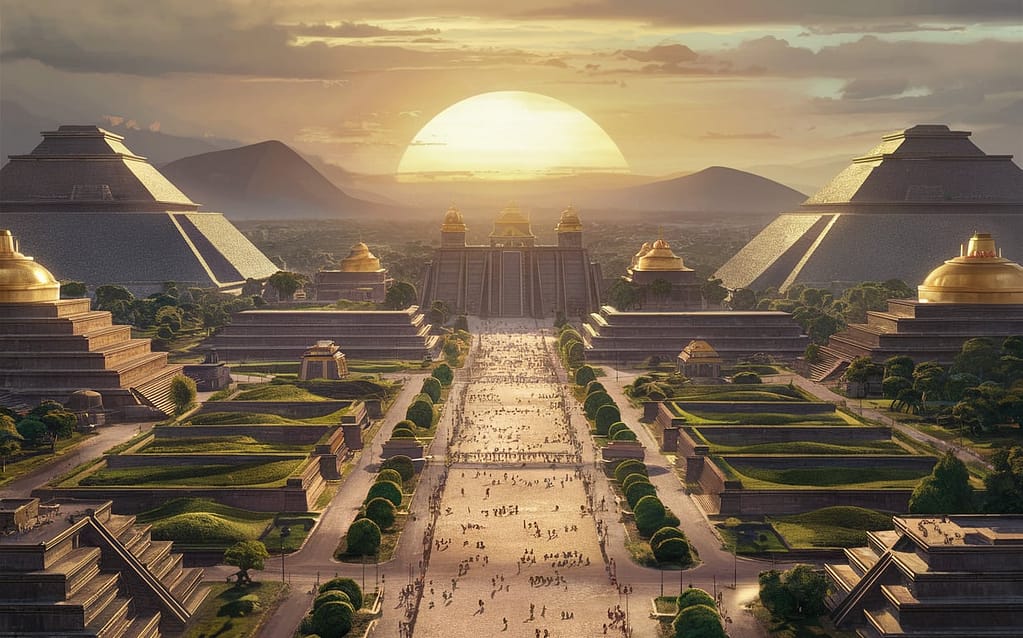The Mu Continent: Myth or Reality? In the Footsteps of Lost Civilizations
The Origin of the Myth: Echoes of a Lost Paradise

Mu kıtası efsanesi, 19. yüzyılda yaşamış olan yazar ve gezgin Augustus Le Plongeon’un çalışmalarıyla popülerlik kazanmıştır. Le Plongeon, Maya uygarlığının kalıntıları üzerinde yaptığı araştırmalar sırasında, onların kökenlerinin Pasifik Okyanusu’nda batmış olan kadim bir kıtaya dayandığına inanmaya başlamıştır. Bu kayıp kıtaya “Mu” adını vermiş ve bu uygarlığın Mısır ve diğer antik kültürlere de ilham kaynağı olduğunu öne sürmüştür. 1
Ancak Mu efsanesinin kökleri, Le Plongeon’dan çok daha eskilere dayanmaktadır. Dünyanın farklı bölgelerindeki pek çok kültürde, büyük tufanlar veya felaketler sonucu sulara gömülen kayıp kıtalar veya uygarlıklarla ilgili benzer efsaneler bulunmaktadır. Örneğin, Yunan mitolojisindeki Atlantis efsanesi, Hinduizm’deki Kumari Kandam efsanesi ve Kelt mitolojisindeki Ys efsanesi, Mu kıtasıyla benzerlikler taşımaktadır. 2
The common point of these myths is that these societies, which generally had an advanced civilization, were punished and destroyed because of their arrogance or defiance of the gods. These themes carry a deep archetypal meaning about humanity's ancient past and helplessness in the face of nature. The Mu myth also exemplifies these universal themes.
Le Plongeon’un çalışmaları, Efsaneyi modern dünyaya tanıtmış olsa da, efsanenin kökeni çok daha eski ve karmaşık bir yapıya sahiptir. Farklı kültürlerdeki benzer efsaneler, insanlığın ortak bir geçmişe veya kolektif bilinçdışına işaret ediyor olabilir. Bu ortak bilinçdışının bir yansıması olarak, insanlığın kayıp cennetine duyduğu özlemi ve geçmişteki ihtişamlı uygarlıklara duyduğu hayranlığı temsil etmektedir.
Augustus Le Plongeon ve James Churchward: Mu Kıtası’nın Tutkulu Savunucuları
Augustus Le Plongeon (1826-1908) and James Churchward (1851-1936) are two important figures who introduced and popularized the Mu myth to the modern world. Both were considered controversial and unusual figures in their time.
Augustus Le Plongeon
Fransız asıllı Amerikalı bir fotoğrafçı, antikacı ve amatör arkeolog olan Le Plongeon, 19. yüzyılın ortalarında Maya uygarlığı üzerine yaptığı çalışmalarla tanınmıştır. Meksika’daki Yucatán Yarımadası’nda bulunan Uxmal ve Chichen Itza gibi önemli Maya şehirlerinde yaptığı kazılar ve fotoğraf çekimleriyle Maya kültürüne büyük ilgi uyandırmıştır. 3
Le Plongeon, Maya hiyerogliflerini deşifre etmeye çalışmış ve kendi yorumlarına dayanarak Mu kıtası efsanesini geliştirmiştir. Ona göre, Mayalar, Mu kıtasından gelen göçmenlerin torunlarıydı ve bu kadim uygarlık, Mısır ve diğer antik kültürlere de ilham kaynağı olmuştu. Le Plongeon’un iddiaları, dönemin bilim insanları tarafından büyük ölçüde reddedilmiş olsa da, Mu kıtası efsanesinin yayılmasında önemli bir rol oynamıştır. 4
James Churchward
İngiliz asıllı Amerikalı bir yazar, kaşif ve mühendis olan Churchward, 20. yüzyılın başlarında efsanenin daha da geniş kitlelere ulaştırmıştır. Hindistan’da askerlik yaptığı dönemde, antik bir tapınakta gizli kalmış tabletler bulduğunu ve bu tabletlerde Mu kıtasının tarihine dair bilgiler yer aldığını iddia etmiştir. 5
Churchward, Mu kıtasını Pasifik Okyanusu’nda yer alan devasa bir kara parçası olarak tanımlamış ve bu uygarlığın 50.000 yıl önce var olduğunu öne sürmüştür. Ona göre, tüm insanlığın beşiğiydi ve buradan dünyanın farklı bölgelerine göç eden insanlar, farklı uygarlıkları kurmuşlardı. Churchward’ın iddiaları da bilimsel çevrelerce kabul görmemiş olsa da, yazdığı kitaplar ve verdiği konferanslarla Mu efsanesini popüler kültürün bir parçası haline getirmiştir. 6
Le Plongeon ve Churchward’ın çalışmaları, bugünkü popülaritesini kazanmasında büyük rol oynamıştır. Her ne kadar bilimsel kanıtlarla desteklenmese de, bu iki araştırmacının tutkulu savunuculuğu, Mu efsanesinin hala ilgi çekici ve gizemli bir konu olarak kalmasını sağlamıştır.

Features: The Splendor of Lost Paradise
Mu legends depict the fascinating features of this lost civilization in various ways. The stories about its geographical location, climate, culture, technology, and people resemble a utopia.
Geographical Location: Mu kıtasının, Büyük Okyanus’un ortasında, günümüzdeki Hawaii Adaları, Paskalya Adası ve diğer Polinezya adaları arasında geniş bir alanı kapladığına inanılmaktadır. Kimi kaynaklarda ise kıtanın, Asya ve Amerika kıtaları arasında bir köprü görevi gördüğü belirtilmektedir. 5
Climate: The climate of the Mu continent is described as mild and sunny throughout the year. With its fertile soil, lush forests, and clear waters, it is said to resemble a paradise garden. 7
Culture: The Mu civilization is described as having a high cultural and spiritual development. It is stated that they reached an advanced level in the fields of art, science, philosophy, and religion. They are said to be particularly skilled in architecture and to have built magnificent temples, palaces, and monuments. 8
Technology: The Mu civilization is claimed to have knowledge and technology that surpasses even today's technology. They are described as having extraordinary abilities such as flying machines, energy crystals, telepathy, and levitation. It is also said that they could predict and control natural disasters such as earthquakes and volcanic eruptions. 9
People: The inhabitants of the Mu continent are described as physically beautiful, tall, and blond-haired. They are said to be peaceful, wise, and spiritually developed. It is also described that all people were equal and had a classless and fair social structure. 10
This information about the features of the Mu continent is, of course, not supported by scientific evidence. However, these legends offer important clues about humanity's ancient past and the dream of an ideal civilization. Even if it is a utopia that never existed, it keeps alive the belief in humanity's potential to create a better world.
The Sinking of Mu Continent:

It is one of the most dramatic and mysterious aspects of the legend. Different sources and researchers have put forward various theories about the causes of this event.
1. Natural Disasters:
- Volcanic Eruptions and Earthquakes: The most common theory is that the Mu continent sank as a result of violent volcanic eruptions and earthquakes. According to this theory, the massive volcanoes under the continent became active and caused large lava flows, earthquakes, and tsunamis. As a result of these disasters, the continent sank into the depths of the ocean with a great noise. 5
- Pole Shift: Bazı araştırmacılar, Mu kıtasının batışının, Dünya’nın manyetik kutuplarının kayması sonucu gerçekleştiğini öne sürmektedir. Bu teoriye göre, kutup kayması, kıtanın dengesini bozmuş ve büyük bir çöküşe neden olmuştur. 11
2. Divine Wrath:
- Punishment of the Gods: Another theory is that the Mu civilization was subjected to the wrath of the gods and punished for their arrogant and immoral behavior. According to this theory, the gods destroyed the Mu continent with a great flood or rain of fire. 12
3. War and Internal Conflicts:
- Technological War: Some sources suggest that the Mu civilization misused its advanced technology, leading to internal conflicts and a devastating war. According to this theory, they perished with the weapons they created themselves. 13
4. Other Theories:
- Alien Intervention: Some conspiracy theories claim that the sinking of the Mu continent occurred as a result of the intervention of extraterrestrial beings.
- Time Cycle: Bazı ezoterik kaynaklar, Mu kıtasının batışının, Dünya’nın belirli bir zaman döngüsünün sonu olduğunu ve bu olayın tekrarlanabileceğini öne sürmektedir.
The real reason for the sinking of the Mu continent is still unknown. However, these theories help us ask important questions about humanity's past and future and consider different possibilities. The Mu legend may one day be illuminated by scientific research and reveal its true face.

Other Legends Related to the Continent of Mu: Hidden Connections Between Lost Continents
Mu efsanesi, yalnız değildir. Dünya üzerinde farklı kültürlerde ve coğrafyalarda benzer kayıp kıta efsaneleri bulunmaktadır. Bunlardan en bilinenleri Atlantis ve Lemuria’dır. Bu efsaneler arasında ilgi çekici paralellikler ve olası bağlantılar bulunmaktadır.
Atlantis: Yunan filozof Platon tarafından anlatılan Atlantis efsanesi, M.Ö. 9000 yıllarında Atlas Okyanusu’nda yer aldığı düşünülen gelişmiş bir uygarlıktan bahseder. Atlantisliler, ileri teknolojiye, zengin kültüre ve güçlü bir donanmaya sahip olarak tasvir edilirler. Ancak kibirleri ve tanrılara karşı gelmeleri sonucu bir gece içinde sulara gömülerek yok olmuşlardır. 14
Lemuria: Hint Okyanusu’nda yer aldığına inanılan Lemuria (ya da Mu), 19. yüzyılda ortaya atılmış bir efsanedir. Madagaskar ve Hindistan arasındaki bazı jeolojik benzerliklerden yola çıkılarak oluşturulan bu efsane, zamanla mistik ve ezoterik öğelerle zenginleşmiştir. Lemuria’nın, Mu gibi gelişmiş bir uygarlığa ev sahipliği yaptığı ve doğal afetler sonucu battığı düşünülmektedir. 15
Connections Between Mu, Atlantis, and Lemuria:
- Geographical Location: Although all three continents are located in different oceans, some researchers suggest that these continents may have been connected or different parts of the same continent. According to this theory, the continents broke apart as a result of sinking, leading to the emergence of new civilizations in different regions. 16
- Technology and Culture: All three civilizations are said to have possessed advanced technology, rich culture, and spiritual wisdom. These similarities suggest the possibility of interaction or a common origin between these civilizations. 17
- Reasons for Sinking: All three continents are thought to have sunk due to natural disasters or divine wrath. This commonality suggests that these legends may have been created to emphasize humanity's helplessness in the face of nature and the consequences of arrogance. 18
Mu, Atlantis ve Lemuria efsaneleri arasındaki bu bağlantılar, bazı araştırmacılar tarafından ortak bir “kayıp uygarlık”ın varlığına kanıt olarak gösterilmektedir. Ancak bu iddialar, bilimsel olarak henüz kanıtlanmamıştır. Yine de bu efsaneler, insanlığın kadim geçmişine ve evrensel arketiplere dair önemli ipuçları sunmaktadır.
Popüler Kültürdeki Yeri: Mu Kıtası’nın Büyülü Etkisi
The legend of the Mu continent, with its mysterious and exotic atmosphere, has been a source of inspiration for artists, writers, and filmmakers for centuries. Appearing in books, movies, TV series, and even video games, Mu has carved out a significant place in popular culture.
Mu in Literature:
- The Lost Continent of Mu (1926): James Churchward’ın bu eseri, Mu efsanesini modern dünyaya tanıtan ve popülerleştiren en önemli kitaplardan biridir. Churchward, kitabında Mu uygarlığının tarihini, kültürünü ve teknolojisini detaylı bir şekilde anlatarak okuyucuları büyülü bir yolculuğa çıkarır.
- The Story of Atlantis & the Lost Lemuria (1904): William Scott-Elliot’ın bu kitabı, Mu (Lemuria) ve Atlantis efsanelerini karşılaştırmalı olarak ele alır. Scott-Elliot, her iki uygarlığın da yüksek bir spiritüel ve teknolojik gelişmişliğe sahip olduğunu ve doğal afetler sonucu yok olduklarını savunur.
- Mu: The Motherland (1931): Churchward’ın bir diğer önemli eseri olan bu kitap, Mu kıtasının dünya üzerindeki diğer uygarlıklarla olan bağlantılarını ve etkisini inceler. Churchward, Mu’nun insanlık tarihini şekillendiren önemli bir güç olduğunu öne sürer.
Mu in Film and Television:
- Mu (1978): Directed by Japanese filmmaker Masahiro Shinoda, this film depicts the sinking of the Mu continent and the survivors spreading to different parts of the world to establish new civilizations. The film is notable for its visual effects and fantastical atmosphere.
- Stargate SG-1 (1997-2007): Bu popüler bilim kurgu dizisinde, Antikler olarak bilinen kadim bir ırkın, Mu kıtasından göç ederek Dünya’ya geldiği ve burada gelişmiş bir uygarlık kurduğu anlatılır. Dizide, Antiklerin teknolojisi ve bilgisi, günümüz insanları tarafından keşfedilir ve evrenin sırlarını çözmek için kullanılır.
- The Venture Bros. (2003-2018): In this animated series, Mu is depicted as a place where secret organizations and superheroes battle. In the series, the descendants of those who survived the sinking of the Mu continent still exist today.
Mu in Video Games:
- Megami Tensei II (1990): In this Japanese role-playing game, Mu is depicted as a place where demons and gods battle. Players travel through the ruins of the Mu continent, fighting demons and trying to save the world.
- Uncharted 2: Among Thieves (2009): In this action-adventure game, Mu appears as a mysterious place where lost treasures are hidden. Players complete challenging tasks to reach the ruins of the Mu continent and seize the treasures.
With these diverse reflections in popular culture, the Mu legend continues to keep humanity's imagination and curiosity alive. Although not scientifically proven, Mu remains a powerful symbol that fuels our curiosity about lost civilizations and the origins of humanity.
Bilimsel Araştırmalar ve Bulgular: Mu Kıtası’nın Bilimsel İmtihanı
Scientific research on the existence of the Mu continent has been carried out in various disciplines from the 19th century to the present day. Studies in geology, archaeology, oceanography, and other related fields have questioned the reality of Mu, and scientists have put forward different views in light of the findings.
Geological Research:
- Plate Tectonics: Levha tektoniği teorisi, yer kabuğunun sürekli hareket halinde olan levhalardan oluştuğunu ve bu levhaların birbirleriyle etkileşimleri sonucu kıtaların şekillendiğini açıklar. Bu teoriye göre, Pasifik Okyanusu’nda Mu kıtası büyüklüğünde bir kara parçasının batması jeolojik olarak mümkün değildir. Zira böyle bir olayın izleri, okyanus tabanında ve çevresindeki kıtalarda açıkça görülebilir olmalıdır. 19
- Ocean Floor Research: Sonar teknolojisi kullanılarak yapılan okyanus tabanı araştırmaları, Pasifik Okyanusu’nda Mu kıtasına ait herhangi bir kalıntıya rastlanmadığını göstermektedir. Aksine, okyanus tabanı, milyonlarca yıl boyunca yavaş yavaş oluşan volkanik dağlar, sırtlar ve çukurlardan meydana gelmektedir. 20
Archaeological Research:
- Polynesian Civilizations: Polinezya adalarında yapılan arkeolojik kazılar, bu bölgedeki uygarlıkların kökeninin Mu kıtasına değil, Güneydoğu Asya’dan gelen göçlere dayandığını göstermektedir. Dilbilimsel ve genetik çalışmalar da bu bulguları desteklemektedir. 21
- Maya Civilization: Maya uygarlığı üzerine yapılan araştırmalar, onların kökenlerinin Orta Amerika’da geliştiğini ve Mu kıtasıyla doğrudan bir bağlantısı olmadığını ortaya koymaktadır. Maya dilinin ve kültürünün, diğer Mezoamerikan uygarlıklarıyla benzerlikler taşıdığı görülmektedir. 22
Scientists' Views:
- Skeptical Approach: Most scientists believe that there is no scientific evidence for the existence of the Mu continent. Geological and archaeological findings do not support the Mu legend. Therefore, the Mu continent is generally considered a legend or myth.
- Alternative Explanations: Bazı araştırmacılar, Mu efsanesinin gerçek bir olaya veya yere dayanabileceğini düşünmektedir. Örneğin, bazıları Mu kıtasının, Paskalya Adası gibi volkanik patlamalar sonucu yok olan küçük bir ada olabileceğini öne sürmektedir. Diğerleri ise, Mu efsanesinin, farklı kültürlerdeki ortak bir “kayıp cennet” arketipini yansıttığını düşünmektedir.
Scientific research on the existence of the Mu continent continues. However, the findings so far do not support the reality of the Mu continent. Nevertheless, this legend helps us to ask important questions about humanity's past and imagination and to consider different possibilities.
A Critical Look: Is Mu Continent Real, or Just a Myth?
The legend of the Mu continent has captivated the human imagination for centuries, remaining shrouded in mystery. While some believe this legend is based on a real foundation, others reject these claims due to the lack of scientific evidence.
The Mu Continent through the Eyes of Believers:
Those who believe in the Mu continent argue that this legend isn't just a myth but tells the story of the existence and disappearance of a real civilization. According to them, Mu is an important part of human history, and the legacy of this civilization still leaves its mark on today's cultures.
- Esoteric and Spiritual Beliefs: Some esoteric and spiritual groups view the Mu continent as the spiritual origin of humanity. They believe the Mu civilization reached a high level of consciousness and discovered the secrets of the universe. These groups interpret the sinking of Mu as a symbol of humanity's spiritual decline. 23
- Alternative History Theories: Some researchers criticize the official understanding of history, which doesn't accept the existence of Mu. They believe that lost civilizations like Mu could reveal unknown or hidden aspects of human history. These researchers think that evidence for Mu's existence is hidden among archaeological findings and ancient texts that cannot be explained by traditional scientific methods. 24
The Mu Continent through the Eyes of Skeptics:
Those who approach the Mu continent with skepticism argue that this legend is not supported by scientific evidence and contradicts geological and archaeological facts. They believe that Mu is merely a myth or a figment of the imagination.
- Lack of Scientific Evidence: Mu kıtasının varlığına dair somut bir kanıt bulunmamaktadır. Jeolojik araştırmalar, Pasifik Okyanusu’nda böyle bir kıtanın batmış olabileceğine dair herhangi bir iz bulamamıştır. Arkeolojik bulgular da, Mu uygarlığına ait olduğu iddia edilen yapıların veya eserlerin gerçekliğini doğrulamamaktadır. 25
- Origin of the Legend: The Mu continent legend gained popularity with the works of researchers like Augustus Le Plongeon and James Churchward in the 19th century. However, the methods and claims of these researchers are criticized by the scientific community. Therefore, the credibility of the Mu continent legend is questioned.
Conclusion
The Mu continent legend remains a controversial topic. Believers and skeptics present different arguments to defend their perspectives. However, it is a fact that no scientific evidence has been found to support the existence of Mu. Therefore, it's important to approach the Mu continent legend with a critical eye and evaluate the views of both believers and skeptics. Perhaps one day, new scientific discoveries will shed light on this mystery and reveal the true face of the Mu continent.
Sources:
Sources:
- Churchward, J. (2007). The Lost Continent of Mu. Adventures Unlimited Press.[↩]
- Hancock, G. (2012). Fingerprints of the Gods: The Evidence of Earth’s Lost Civilization. Crown.[↩]
- Le Plongeon, A. (1999). A Fall from Archaeological Grace. Assembling the Past: Studies in the Professionalization of Archaeology, 81.[↩]
- Childress, D. H. (1988). Lost cities of ancient Lemuria & the Pacific. (No Title).[↩]
- Churchward, J. (2007). The Lost Continent of Mu. Adventures Unlimited Press.[↩][↩][↩]
- William R. Corliss, “Mysteries of the Unexplained”[↩]
- Joseph, F. (2006). The lost civilization of Lemuria: the rise and fall of the world’s oldest culture. Simon and Schuster.[↩]
- Scott-Elliot, W. (2022). The story of Atlantis and the lost Lemuria. DigiCat.[↩]
- Churchward, J. (2007). The Sacred Symbols of Mu. Cosimo, Inc..[↩]
- Cervé, W. S. (1960). Lemuria, the Lost Continent of the Pacific (Vol. 12). Print. and Pub. Department.[↩]
- Flem-Ath, R., & Flem-Ath, R. (1997). When the Sky fell: in Search of Atlantis. Macmillan.[↩]
- Hancock, G. (2015). Magicians of the Gods: Evidence for an Ancient Apocalypse. Hachette UK.[↩]
- Childress, D. H. (1986). Lost cities & ancient mysteries of South America. Blue Poppy Enterprises, Inc..[↩]
- Platon, “Timaeus ve Critias”[↩]
- Sclater, P. L. (1864). The mammals of Madagascar. Quarterly Journal of Science, 1(2), 213-19.[↩]
- Hancock, G. (2009). Underworld: The mysterious origins of civilization. Crown.[↩]
- Scott-Elliot, W. (2022). The story of Atlantis and the lost Lemuria. DigiCat.[↩]
- Donnelly, I. (2006). Atlantis: The antediluvian world. Book Tree.[↩]
- Kearey, Philip, Klepeis, Keith A., Vine, Frederick J. “Global Tectonics”[↩]
- Menard, H. W. “Marine Geology of the Pacific”[↩]
- Kirch, Patrick Vinton. “On the Road of the Winds: An Archaeological History of the Pacific Islands Before European Contact”[↩]
- Coe, Michael D. “The Maya”[↩]
- Fire, A. Treatise On Cosmic. “A Treatise On Cosmic Fire.”[↩]
- Hancock, G. (2012). Fingerprints of the Gods: The Evidence of Earth’s Lost Civilization. Crown.[↩]
- Witzel, M. (1999). The Pleiades and the Bears viewed from inside the Vedic texts. Electronic Journal of Vedic Studies, 5(2), 17-26.[↩]
